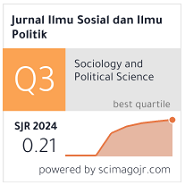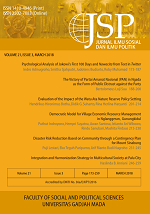Public Trust and Regulatory Compliance
Ambar Widaningrum(1*)
(1) Faculty of Social and Political Sciences Gadjah Mada University
(*) Corresponding Author
Abstract
Several studies have proven that public trust in government improves the level of policy or regulation acceptance and reduce administrative costs. In contexts where trust in government is high, citizens tend to be more willing to voluntarily comply with public policies. This article aims to explore issues of trust and distrust toward government, seen from the aspect of public compliance, both to rules or policies. The level of public trust toward government is expressed by giving its support through its conduct which complies with the existing rules. This study employed a case study research design, which was conducted in Yogyakarta, July 2015 – March 2016. It assessed the government regulation on Traffic and Road Transport and Local Regulation on Street Vendors Management. This study concludes that a number of non-compliant behaviors is a form of low publictrust in government. Disobedience is a representation of government failure to enforce the rule of law which resulted in some of the processes and procedures of public services that have not been followed by people. Level of public trust in the government regulation is an output of a variety of interrelated elements: the performance of the implemented regulation to solve public problems; consistency in the regulation’s enforcement and fairness, and government officials’ behavior, demonstrated through exemplary attitude.
Keywords
Full Text:
PDFReferences
Baxter, P. & Jack, S. (2008). Qualitative Case Study Methodology: Study Design and Implementation for Novice Researchers. The Qualitative Report, 13(4), 544-559.
Blind, Pery, K. (2006). Building Trust in Government in the Twenty-First Century: Review of Literature and Emerging Issues. Austria: The United Nations Department of Economic and Social Affairs.
BPS-Statistics of D.I. Yogyakarta Province. (2015). Yogyakarta Province 2015 in Figures. Yogyakarta, Indonesia.
Bouckaert, G. & Van de Walle, S. (2003). “Comparing Measures of Citizen Trust and User Satisfaction as Indicators of ‘Good Governance’: Difficulties in Linking Trust and Satisfaction Indicators”. International Review of Administrative Science, 69(3), 329-343.
Castillo, J.C., D Miranda, D & Pablo Torres, P. (2011). Authoritarianism, Social Dominance and Trust in Public institution. Retrieved from http://mideuc.cl/wp-content/ uploads/2011/11/1107-castillo-mirandatorres-2011-trust-SDO-
RWA-ISPP. pdf
Choudhury, E. (2008). “Trust in Administration: An Integrative Approach to Optimal Trust”, Administration & Society, 40(6), 586-620.
Christense, T. & Laegreid, P. (2003). “Trust in Government – the Significance of Attitudes Towards Democracy, the Public Sector and Public Sector Reforms”. Working paper. Retrieved from http://www.ub.uib.no/elpub/rokkan/N/N07-
03.pdf
Diamond, L. (2007). “Building Trust in Government by Improving Governance”. Paper Presented to the 7th Global Forum on Reinventing Government: Building Trust in Government, June 27, 2007, Sponsored by the United Nations, Vienna.
Dwiyanto, A. (2011). Membangun Kepercayaan Publik melalui Reformasi Birokrasi. Jakarta:Gramedia Pustaka Utama.
Edelmen (The). (2017). The 2017 Edelman Trust Barometer: Global and Indonesia. Retrieved from https://edelman.id/Rtrust2017/wpcontent/uploads/2017/02/2017TrustBarometer_Indonesia_FINAL-VERSIONShare.pdf
Fukuyama, F. (1995) Trust: The Social Virtues and the Creation of Prosperity. New York: The Free Press.
Im, T., Cho, W., Porumbescu, G., & Park, J. (2014). “Internet, trust in government, and citizen compliance”. Journal of Public Administration Research and Theory, 24, 741-763, httpx://dx.doi.org/10.1093/ jopart/mus037
Kim, S-E. (2005). “The Role of Trust in the Modern Administrative State: An Integrative Model”, Administration & Society, 37(5): 611-635.
Kleinnijenhuis, J., Anita M.J.van Hoof, & Dirk Oegema. (2006) “Negative News and the Sleeper Effect of Distrust”. Press/Politics 11(2), 86-104, httpx://dx.doi. org/10.1177/1081180X06286417
Milgram, S. (1963). Behavioral study of obedience. Journal of Abnormal and Social Psychology, 67, 371-378
Montgomery, K., Jordens, C.F.C & M. Little. (2008). “How Vulnerability and Trust Interact During Extreme Events: Insight 635 for Human Service Agencies and Organization”. Administration and Society, 40(6), 621-44.
Nixon, D. (2007). The Role and Meaning of Trust in Institutions. Retrieved from http://www.trustlearningsolutions.com/wpincludes/ images/ValuesConference07.pdf
OECD. (2013). “Trust in Government”, in Government at a Glance 2013. OECD Publishing. http://dx.doi.org/10.1787/gov_glance-2013-7-en
Putnam, R. (1993). Making Democracy Work: Civic Traditions in Modern Italy. Princeton, N.J.:Princeton University Press.
Rawlins, B.L. (2008) “Measuring the relationship between organizational transparency and employee trust”. Public Relations Journal, 2(2), 1-21.
Scholz, J. T., & Lubell, M. (1998). “Trust and taxpaying: Testing the Heuristic Approach to Collective Action”. American Journal of Political Science, 42, 398-417.
See Beh, L. (2013). “The Changing Face of Government: The Politics of Policy Change”. International Journal of Policy Studies, 4(1), 105-13.
Tashakkori, A. & C. Teddlie. (1998). Mixed Methodology: Combining Qualitative and Quantitative Approach. London: Sage Publication.
Walker, R. M. (2011) “Globalized Public Management: An Interdisciplinary Design Science?” Journal of Public Administration Research and Theory. http://dx.doi.org/10.1093/jopart/muq064
Yin, R. K. (1994) Case Study Research: Design and Methods. Second Edition. London: Sage Publication.
_______. (2003), Applications of Case Study Research. London: Sage Publication.
Zahroh, W. (2015). “Government Roles in Law Enforcement of the Implementation of Traffic Law”. Unpublished Undergraduate Thesis. Yogyakarta: Department of Public Policy and Management, Universitas Gadjah Mada.
Article Metrics
Refbacks
- There are currently no refbacks.
Copyright (c) 2017 Jurnal Ilmu Sosial dan Ilmu Politik

This work is licensed under a Creative Commons Attribution-NonCommercial-NoDerivatives 4.0 International License.






















